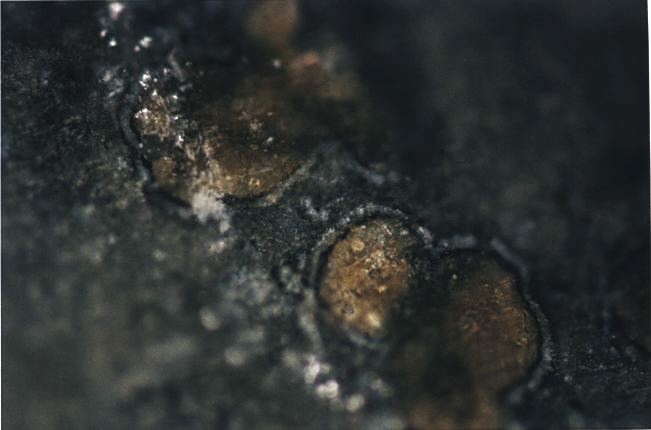
The now famous Martian meteorite ALH84001, which is thought by some to contain 3.6 billion year old fossilized Martian microbes.
Following the early theories of Martian life by Percival Lowell (which were mostly discredited by the early 1900's), there was little progress until the space age. With the first flyby and orbiter missions of the 1960's, it became clear that, on the large scale, Mars was a desolate, cratered world. In particular, with the negative results in the life experiments on the Viking missions, the prospect for Martian life seemed grim.
Twenty years after the Viking missions, on August 7, 1996, a NASA team held a press conference: they claimed to have tentative evidence of ancient Martian microbes! The evidence concerned a meteorite found in the Allan Hills region of Antartica (called ALH84001). Based on gases trapped in the meteorite, it is almost universally agreed that the rock is from Mars. It is also agreed that the potato sized object was formed 4.5 billion years ago as an igneous rock that crystallized slowly from molten lava. It was fractured and underwent chemical change while on Mars and was ejected from Mars by an asteroid impact about 16 million years ago (based on its exposure to cosmic rays in space), fell in Antartica 13,000 years ago (based on when cosmic ray exposure stopped), and was discovered in 1984. Whereas these claims are well accepted, the claim that the meteorite holds fossilized Martians is not as widely accepted.

The rock contains tiny globules of carbonate minerals scattered along fractures throughout it. The carbonates may have been deposited in the cracks by Martian groundwater laden with carbon dioxide. All the evidence for life is in the tiny carbonate globules and on their rims. The team reported four lines of evidence for ancient life:

It has been found that some of the compounds in the rock can be formed in the absence of life (and at rather high temperatures for the presence of life as we know it). There are concerns that some of the organic molecules (PAHs - polycyclic aromatic hydrocarbons) might be the result of contamination. However, the concentration of PAHs is greatest in the center of the rock and least at the surface - the opposite of what would be expected if the PAHs result from contamination.
The most exciting signs of Martian life were electron microscope pictures of bacteria-shaped objects (called BSOs). One original concern was that the BSOs are about 2 to 10 times smaller than the smallest known terrestrial bacteria (they were also called "nanobacteria"). The NASA team has changed its position on the BSOs and now think they may be crystals of magnetite or ridges on the mineral surface.

Despite some setbacks, the NASA team says the idea of Martian fossils in ALH84001 is "still alive and kicking" and they are "more confident than ever." Many critics remain and the scientific debate continues.
Goto Section 10 - A Crewed Mission to Mars.
Goto Section 10 - A Crewed Mission to Mars (revised 2003 version).